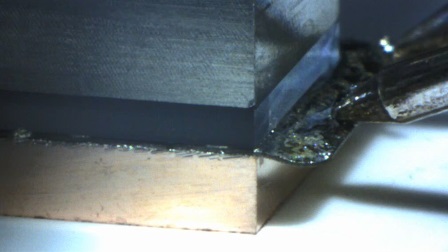Reactive nano-multilayers are considered to be a revolution in joining technology. They are envisaged for joining heat-sensitive materials that would otherwise be damaged or even destroyed upon conventional soldering. But soldering with reactive foils proves to be tricky due to the volatile nature of the reactive foils. Empa researchers have now succeeded in refining the joining process with reactive nano-multilayers, making it available also for sensitive components without any loss in quality.
Making the uncontrollable controllable
 This heat development is difficult to control and is one reason why reactive joining has no widespread use yet. The more different the properties of the materials to be joined, the more inconsistent the result: Copper, for example, is an excellent heat conductor and allows large parts of the heat generated by the foil to drain away rapidly. This heat-loss can hinder the solder from complete melting. Glass, on the other hand, is a poor heat conductor and behaves in the opposite way: it can literally provoke a pile-up of the reaction heat, which can lead to cracking of the glass due to local overheating.
This heat development is difficult to control and is one reason why reactive joining has no widespread use yet. The more different the properties of the materials to be joined, the more inconsistent the result: Copper, for example, is an excellent heat conductor and allows large parts of the heat generated by the foil to drain away rapidly. This heat-loss can hinder the solder from complete melting. Glass, on the other hand, is a poor heat conductor and behaves in the opposite way: it can literally provoke a pile-up of the reaction heat, which can lead to cracking of the glass due to local overheating.
Hence, there is no universal approach when joining with RNMS. Researchers from Empa’s “Joining Technology and Corrosion” department around Bastian Rheingans and Jolanta Janczak-Rusch have now succeeded in joining materials with vastly different properties with this technology. For this purpose, the process is specifically adapted to the properties of the respective materials, for example by carefully choosing the type and thickness of the reactive foil, or the amount of solder. “We can even join copper with glass without damage from heat or thermal stress,” explains Rheingans. The Empa researchers now want to make this know-how available to industry and give support in the development of complex processes.
Targeted development of know-how
In the recent months, Empa researchers have worked together with the Hahn Schickard Society for Applied Research in Villingen-Schwenningen in an “interreg” project – the EU regional programme for the promotion of cross-border cooperation – to increase their combined knowledge for joining sensitive components with the RNMS method. “We now understand how a certain material behaves during reactive joining, and can thus adapt the reactive joining process accordingly,” says Rheingans. Reactive joining allows the assembly of complex structures, also in multiple joining steps, without major technical effort or investments. The Empa researchers therefore anticipate great application potentials especially for sensor technologies, e.g. for the assembly of advanced sensor systems, the on-site installation of sensors, or the production of small series with high value. However, due to its simple and flexible approach reactive joining also offers many opportunities for other fields of application.
Source: EMPA